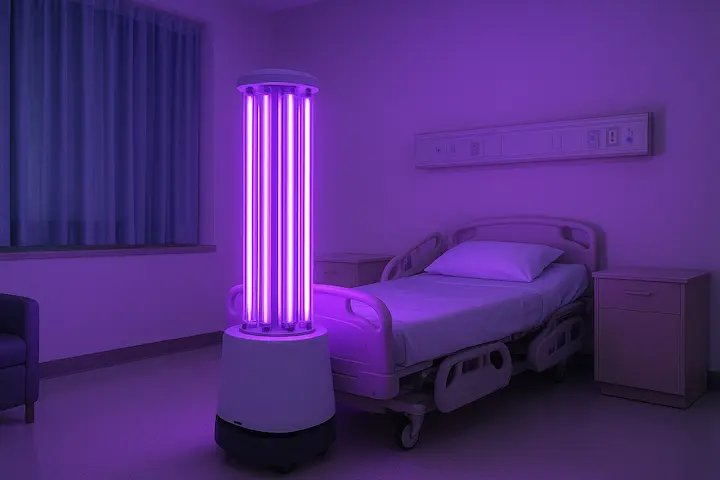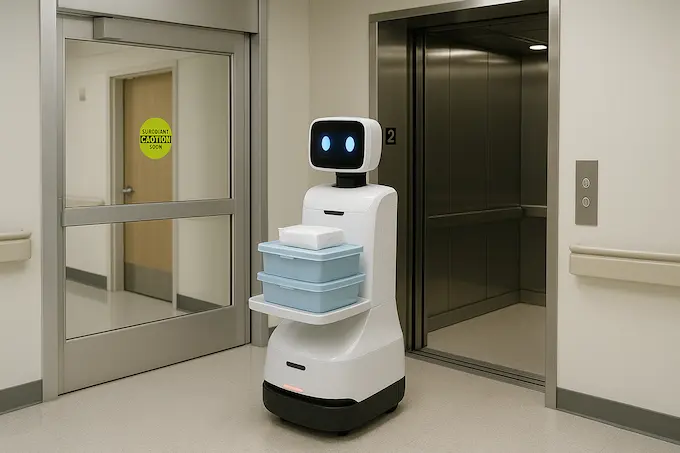Introduction
Hospitals have always been centers of innovation, but today they are experiencing one of the biggest transformations in modern history: the rise of AI Robots in Hospitals. How AI Is Transforming Healthcare . Once limited to research labs, robots are now being deployed in hospital corridors, operating rooms, and even patient therapy sessions.
From cleaning and disinfection robots that fight hospital-acquired infections to surgical robots that support delicate operations with millimeter precision, AI is helping hospitals deliver safer, faster, and more efficient care. What makes this revolution even more powerful is robot coordination—the ability for multiple robots to work together under AI supervision to optimize workflows.
This article explores the major applications of AI-powered robots in hospitals, the benefits they bring, the challenges to adoption, and what the future of healthcare might look like.
Table of Contents
1. Why AI Robots in hospitals
Hospitals face a range of pressures: rising patient numbers, limited staff, increasing costs, and the constant threat of infections. According to the World Health Organization (WHO), hospital-acquired infections affect 7–10% of hospitalized patients globally. Meanwhile, a shortage of healthcare workers is predicted to reach 10 million by 2030.
This is where AI and robotics come in. Robots never tire, can be deployed 24/7, and—when powered by AI—can make intelligent decisions such as adjusting cleaning patterns, navigating crowds, or prioritizing urgent tasks. Instead of replacing humans, these technologies support healthcare workers by taking over repetitive, high-risk, or time-consuming tasks.
2. Cleaning and Disinfection Robots: AI for Infection Control

Infection control is one of the most critical issues in healthcare. Robots that use UV-C light or automated spraying systems are already being used as AI Robots in Hospitals worldwide.
- AI mapping: Robots can scan rooms and calculate the best path for full coverage.
- Safety systems: Motion sensors stop UV exposure when humans are nearby.
- Remote operation: Robots can be scheduled and controlled via wireless apps.
During the COVID-19 pandemic, sales of disinfection robots surged. Hospitals in China, Italy, and the U.S. deployed fleets of UV robots to sterilize ICUs and waiting areas, dramatically reducing viral contamination.
💡 Fact: A study in the American Journal of Infection Control found that UV-C robots reduced surface contamination of dangerous pathogens like MRSA by 93%.
3. Social and Assistive Robots: AI That Connects With Patients
Beyond cleaning, robots are also transforming patient interaction. Social and assistive robots (SARs) support elderly patients, children, and those with long-term conditions.
- PARO (robotic seal): Used in dementia therapy to provide comfort and reduce anxiety.
- NAO (humanoid robot): Helps children with autism improve communication and social skills.
- Robear (Japanese nursing robot): Assists in lifting patients from beds to wheelchairs safely.
AI allows these robots to recognize speech, detect emotions, and even respond to patient moods. For example, PARO reacts to touch and sound, “learning” patient behavior to build trust.
💡 Case Study: In a Japanese nursing home, residents who interacted with PARO showed significant reductions in stress hormones and improvements in mood compared to those receiving standard care.
4. Logistics Robots: AI Behind the Scenes
Not all robots in hospitals interact directly with patients. Some work behind the scenes to make hospital operations smoother.
- TUG robots (by Aethon) deliver meals, medicines, and linens across large hospitals.
- Pharmacy robots prepare prescriptions with near-perfect accuracy.
- Automated guided vehicles (AGVs) move supplies between departments.
With AI, these robots coordinate tasks, avoid busy hallways, and deliver items on time. This frees up nurses and staff, allowing them to focus more on patient care.
5. Surgical Robots: Precision With AI Support
Perhaps the most advanced form of hospital robotics lies in surgery. Robotic surgical systems are already assisting doctors in performing complex procedures with unmatched precision.
- Da Vinci Surgical System: The most widely used robotic surgery platform for urology, gynecology, and cardiology.
- STAR robot (Smart Tissue Autonomous Robot): Recently performed autonomous suturing with greater consistency than human surgeons.
- Yomi dental robot: First FDA-approved dental surgical robot, assisting in implant procedures.
AI enhances surgical robots by analyzing patient scans, guiding tool placement, and reducing the risk of human error.
💡 Fact: Studies show that robotic-assisted surgeries often result in smaller incisions, shorter hospital stays, and faster recovery times compared to traditional surgery.
6. Coordinating Robots in Hospitals: The Power of AI Integration

The real revolution comes when multiple robots coordinate their work under AI supervision. Imagine this scenario:
- A logistics robot delivers sterile tools to an operating room.
- Immediately after surgery, a disinfection robot enters to sterilize the space.
- Meanwhile, a social robot supports the recovering patient with therapy.
AI acts as the orchestrator, ensuring robots don’t collide, tasks don’t overlap, and resources are used efficiently. This type of coordination is already being tested in “smart hospitals” in Asia and Europe.
7. Data Table: Types of AI Robots in Hospitals
| Type of Robot | Examples | Main Functions | Advantages | Limitations | Stage of Development |
|---|---|---|---|---|---|
| Cleaning & Disinfection | UV-C robots, Xenex, UVD | Sterilize rooms and surfaces with UV light/spray | Reduces infections, fast, contactless | Expensive, limited human presence allowed | Widely adopted |
| Social & Assistive | PARO, NAO, Robear | Therapy, rehabilitation, patient assistance | Improves care, builds trust, reduces stress | Acceptance, ethical concerns | Growing adoption |
| Logistics | Aethon TUG, AGVs | Transport medicines, meals, equipment | Saves staff time, reduces errors | Navigation in crowded areas | Widely adopted |
| Surgical | Da Vinci, STAR, Yomi | Assist in surgery with precision | Better outcomes, less invasive | Very high cost, training required | Advanced, expanding use |
8. The Future: AI, AR, VR, and the Hospital Metaverse
Hospitals of the future will be more like digital ecosystems where AI, robotics, and immersive technologies work hand in hand.
- Virtual Reality (VR): Training surgeons in lifelike environments.
- Augmented Reality (AR): Overlaying patient scans during surgery for real-time guidance.
- Teleoperation: Surgeons performing operations remotely via robotic systems.
- Hospital Metaverse: Digital twins of hospitals that allow planning, remote monitoring, and even clinical trials.
💡 Example: The VisAR surgical navigation system (developed by Novarad) uses AR to superimpose 3D anatomy over a patient’s body with sub-millimeter accuracy, helping surgeons operate with greater precision.
9. Challenges in Adopting AI Robots in Hospitals
While the potential is huge, adoption comes with challenges:
- Cost: High purchase and maintenance costs can be a barrier for smaller hospitals.
- Privacy: Robots that collect video/audio data raise concerns about patient confidentiality.
- Training: Staff need proper training to operate and collaborate with robots.
- Ethics: How much care should be automated without losing the human touch?
- Liability: Who is responsible if a robot makes a mistake—doctor, hospital, or manufacturer?
Hospitals, regulators, and technology companies must work together to ensure these concerns are addressed.
Q1. What are AI robots used for in hospitals?
AI robots in hospitals perform cleaning, disinfection, logistics (delivery of medicines and meals), surgery assistance, and patient support through therapy and rehabilitation.
Q2. Are AI-powered robots replacing doctors and nurses?
No. Robots support healthcare workers by handling repetitive, high-risk, or time-consuming tasks, allowing doctors and nurses to focus more on patient care.
Q3. Are disinfection robots safe for humans?
Most use UV-C light, which is harmful to humans, but they are equipped with motion sensors and automatic shut-off features to ensure safety.
Q4. How do robots improve patient care?
Robots reduce infection risks, deliver medicines on time, assist in precise surgeries, and even provide emotional support to patients through AI-enabled therapy robots
Q5. What is the biggest challenge with hospital robots?
High costs, privacy issues, and the need for staff training are the most significant barriers to widespread adoption.
Q6. What is the future of AI robots in healthcare?
Future hospitals will integrate robots with AI, VR, AR, and teleoperation—creating smart, connected healthcare systems capable of personalized treatment and remote operations.
Conclusion:
AI-powered robots are changing hospitals in ways that were unimaginable just a decade ago. From sterilizing hospital rooms and delivering medicines to assisting in complex surgeries and supporting patient therapy, robots are making healthcare smarter, safer, and more efficient.
The next step is coordination—where multiple robots work seamlessly together under AI supervision, turning hospitals into highly efficient ecosystems. While challenges like cost and privacy remain, the benefits of adopting AI-powered robots are undeniable.
As healthcare continues to evolve, hospitals that embrace AI and robotics will not only improve patient safety but also shape the future of modern medicine.


